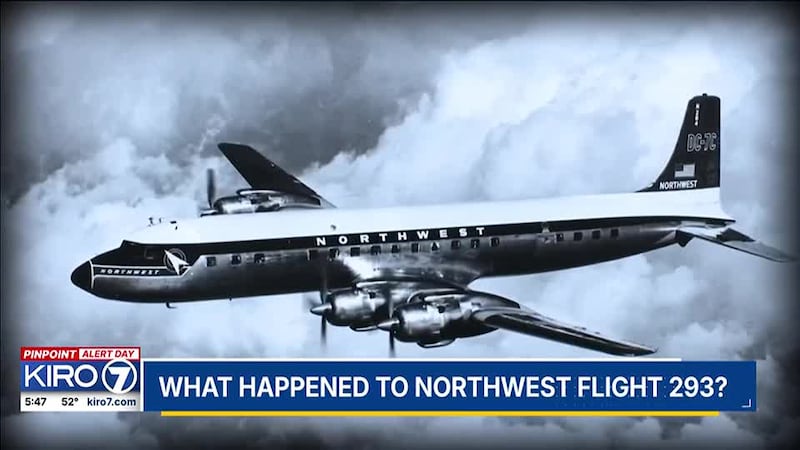On June 3rd, 1963, a heartbreaking and mysterious story quietly began at McChord Air Force Base aboard a Northwest Airlines DC-7.
It’s a story 61 and a half years later--which still has no ending.
17-year-old Bruce Barrowman was a freshly trained Army Private, who slung a loaded duffel over his shoulder as he shook the hand of his 9-year-old brother Greg on the tarmac.
“Be a man,” advised Bruce, as he tipped his hat and joined 101 people saying goodbye to the people they loved before boarding the plane that morning. The flight was bound for a military base in Anchorage, where Bruce and most of the passengers would be stationed during the dawn of the Cold War.
58 members of the military, along with 22 family members, buckled their seat belts. Mixed with uniformed Army, Coast Guard, and Air Force members were their wives and children. In the front, a Seattle-based flight crew of six, four men and two women, prepared the cabin for takeoff.
Two and a half hours after leaving the tarmac at McChord, Flight 293 and all 101 souls on board disappeared.
Below the plane’s last reported altitude of 14,000 feet, churned the vast Gulf of Alaska. There was no distress call from the flight crew. No sign of trouble or dangerous weather, and aside from the shimmer of a rainbow slick coloring the waves, there was no sign of the plane anywhere in the water. Left behind were the surviving families and friends of 101 people mysteriously lost at sea.
“Included is my family member, Bruce Barrowman,” said Greg Barrowman, reminding himself of his brother’s commitment to service. “He was on board as a buck private on his first assignment from Fort Ord California to Fort Richardson in Alaska.”
Greg Barrowman’s big brother had been a kind, athletic, and ambitious high school senior turned soldier--who was only old enough to drive a car one year before Flight 293.
“I was eight, pushing nine,” said Bruce. “My favorite clown J.P. Patches was on KIRO 7 that afternoon. I remember there was a flash warning on the screen. The voice said there had been an incident that took place with a flight. They said it was 293 that left McChord Air Force Base.”
Greg heard his brother Bruce’s name in the report, which prompted him to warn his parents, who were quarreling in the kitchen. Days later, his family got a telegram. Bruce was officially considered “perished” by the U.S. Government.
Days after that, fragments of the plane, mangled seat cushions, and personal items were found, but no people. The official crash reports offered maintenance records with no notable problems. It offered no clues as to why the plane could have suddenly plunged 14,000 feet, before sinking a mile and a half below the surface of the ocean.
“Everybody had the same question that I’ve spoken to,” Greg said. “What happened?”
Greg says because it was a chartered airliner and not a military plane, the Department of Defense never again contacted surviving families, beyond the initial regrets and condolences. Investigators wrote a short report, closed the case, and refused to answer questions.
Bruce Barrowman was never considered “Missing in Action” because there was no action, no combat. Greg’s family had the Army play taps before a memorial flag his parents paid for. Then they buried an empty casket in Renton.
“I’d like to see if we can see at least how it happened,” Greg said. “If an engine came off or a loose propeller. Because there was a plane, one year earlier, that did crash in the same area, and everyone survived. It was like a Sully Sullenberger landing in the water.”
60 years to the day after the crash, Greg and the surviving families raised their own money to build and install their own memorial at Tahoma National Cemetery. Greg had been sharing his story with KIRO Radio’s Resident Historian Feliks Banel, who turned a deep-dive investigation into an eight-episode podcast called “Unsolved Histories.” It raises many new questions about a very old case. It questions the military’s responsibility to re-open the case and consider why the lives sacrificed for the country have never been officially remembered. It also examines the remote possibility of the plane being shot down by mistake.
The timeless memorial notes that while lives like Bruce Barrowman’s are missing--and dearly missed--they are not forgotten.
“I believe that the seven to ten minutes that they had in flight before it actually crashed intact, that they may have made peace with God,” said Greg. “And that being so, well, so have I. And I hope to be reunited again.”
Before that, Greg is praying for the only peace that comes with finding the truth.
©2024 Cox Media Group








